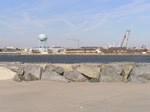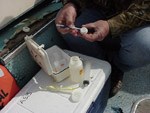
NPS photo 
Terry Wildy Ocean currents, storm events, and seasonal weather patterns are constantly reshaping the island landscape. Long shore currents cause sand to migrate along the coast from north to south, while overwash events push the island toward the mainland by transporting sediments from the seaward beaches to the marshes along the western shore. Manmade structures such as jetties built to the north of the island, in turn, alter these natural processes by inhibiting sediment transport. 
Because of the growing population density in neighboring areas, human land use and development influence water quality and aquatic resources in the surrounding bay and ocean. Park staff continually monitor water quality in these areas, to identify changing conditions and help protect the health of both human and non-human life. Submerged aquatic vegetation within the bay provides vital habitat for many marine organisms, but faces threats from commercial clam fisheries and recreational boating. Recently enacted protections are allowing these important habitats to thrive, ultimately leading to healthier fishing and shell-fishing grounds. Even Assateague Island's famous wild horses exert strong impacts on the park's natural systems. These non-native horses heavily graze the lush marsh grasses that many animals, such as clapper rails (Rallus longirostris) and ribbed mussels (Geukensia demissa), depend on for food and shelter. While an ongoing contraceptive program is controlling horse population growth, achieving an appropriate balance between protecting the horses and their island home may ultimately require a smaller herd size. A more recent issue facing the Island is the threat of vector-borne diseases such as West Nile Virus. Rising planetary temperatures, as well as relocation through human activities, increase the spread of diseases that were once limited to smaller ranges significantly further south of the Island. Despite the many environmental challenges facing Assateague, the Island continues to be a place of habitat richness and recreational opportunities. |
Last updated: February 26, 2015
